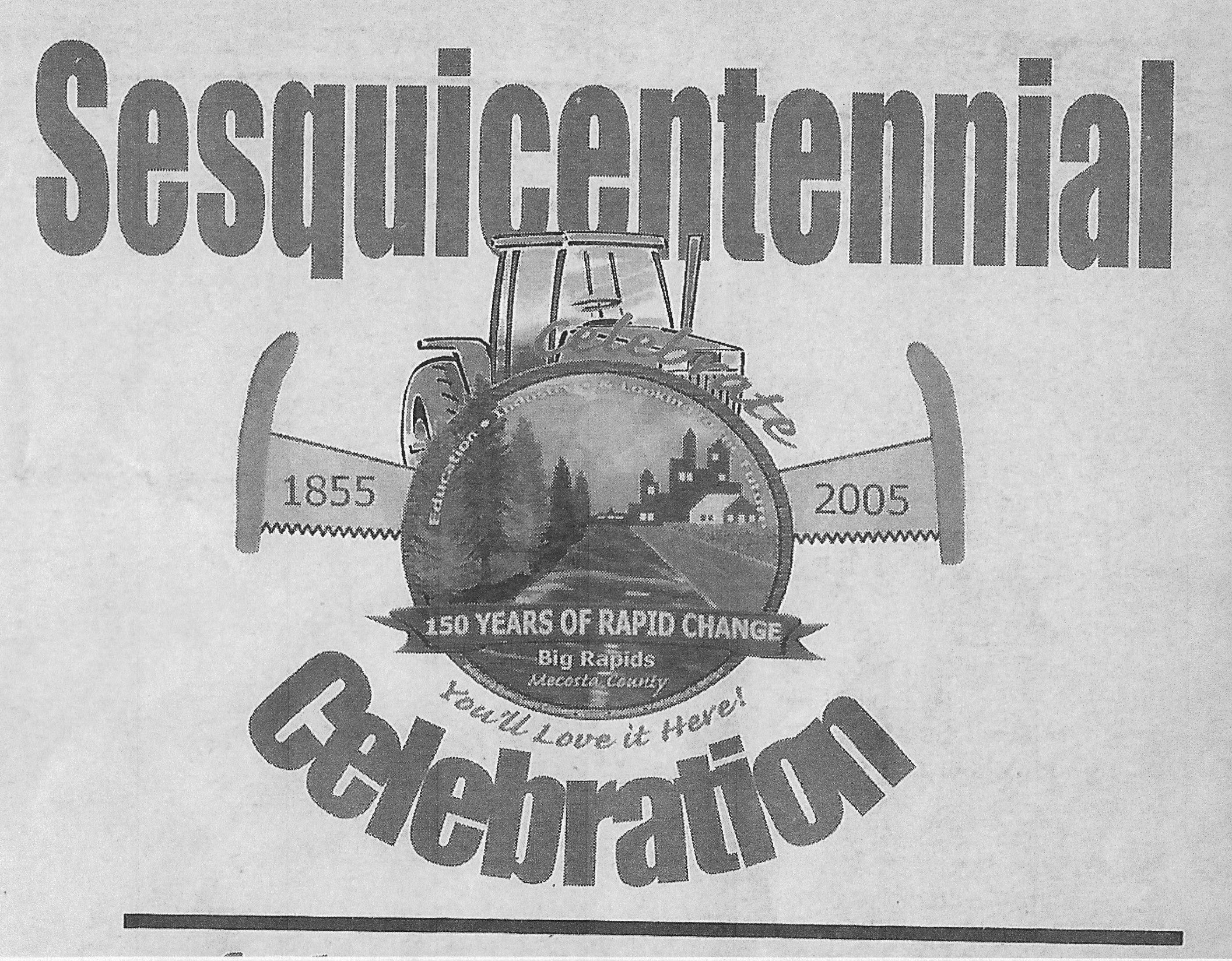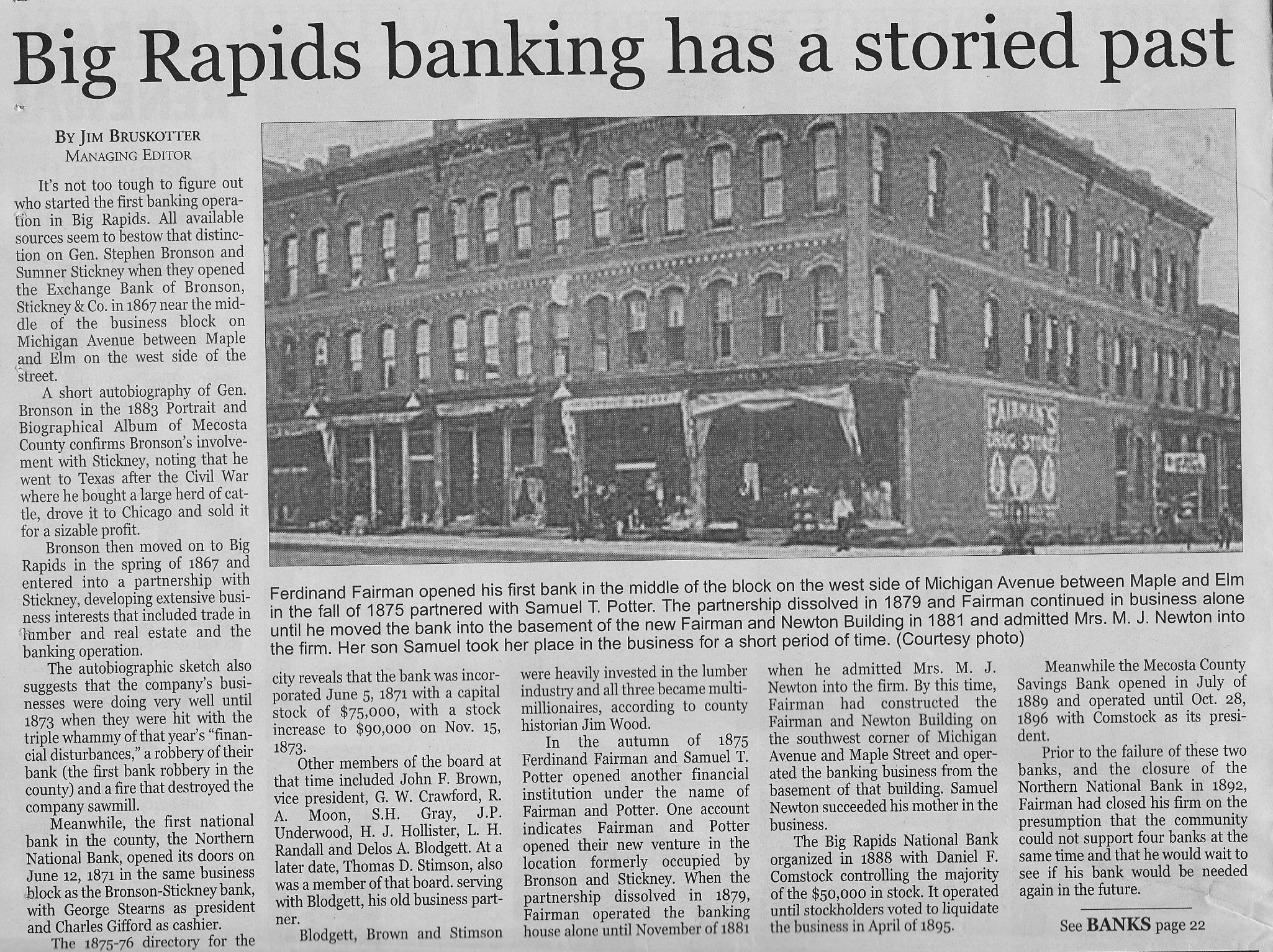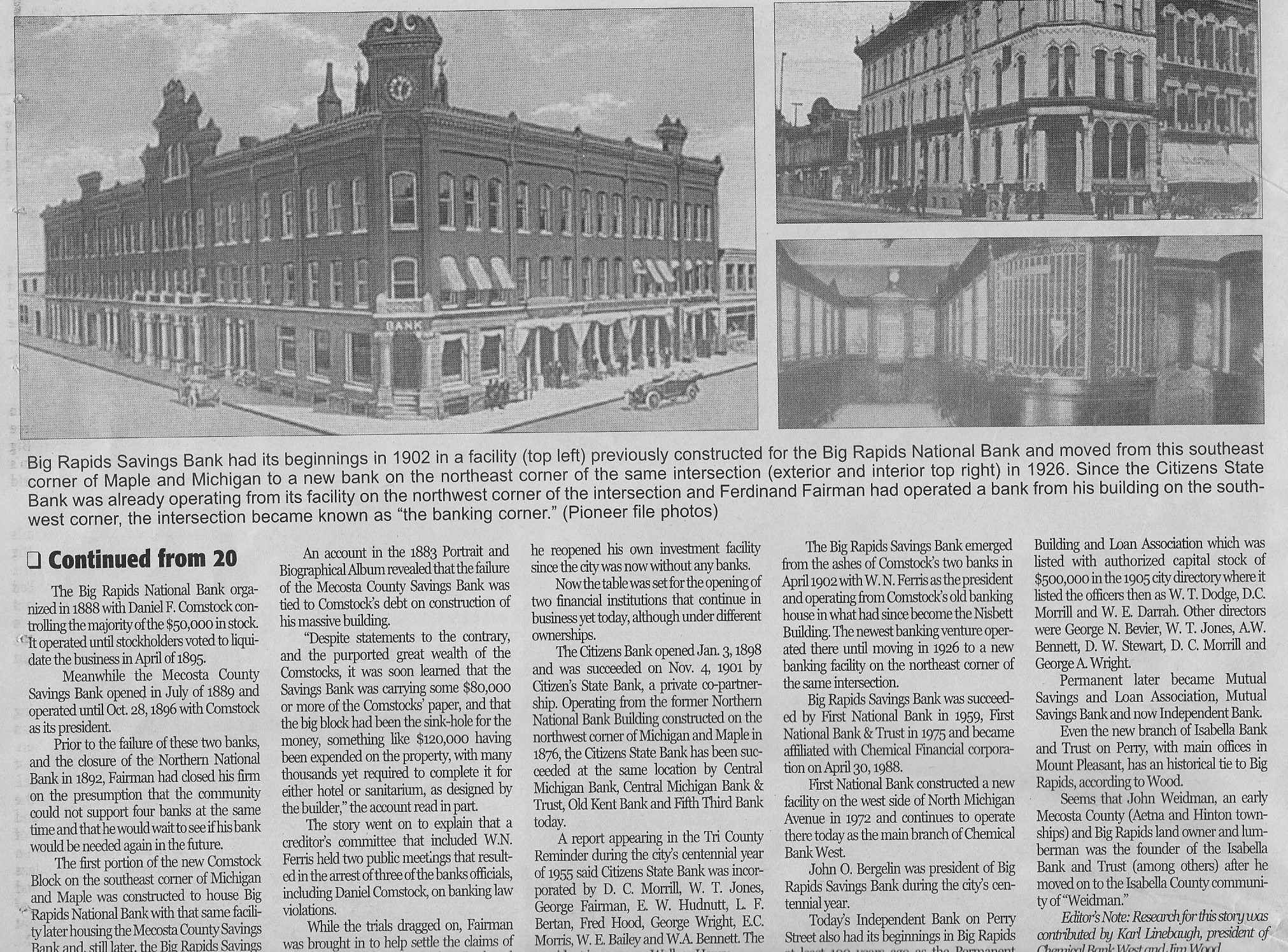
Part II - Business, a supplement to the Big Rapids Pioneer Newspaper. Used with permission.


BIG RAPIDS BANKING HAS A STORIED PAST
It's not to tough to figure out who started the first banking operation in Big Rapids. All available sources seem to bestow that distinction on Gen. Stephen Bronson and Sumner Stickney when they opened the Exchange Bank of Bronson, Stickney & Co. in 1867 near the middle of the business block on Michigan Avenue between Maple and Elm on the west side of the street.
'
A short autobiography of Gen. Bronson in the 1883 Portrait and Biographical Album of Mecosta County confirms Bronson's involement with Stickney, noting that he went to Texas after the Civil War where he bought a large herd of cattle, drove it to Chicago and sold it for a sizable profit.
Bronson then moved on to Big Rapids in the spring of 1867 and entered into a partnership with Stickney, developing extensice business interests that included trade in lumber and real estate and the banking operation.
The autobiuoigraphical sketch also suggests that the company's businesses were doing very well until 1873 when they were hit with the triple whammy of that year's "financial disturbances" a a robbery of their bank (the first bank robbery in the county and a fire that destroyed the company sawmill.
Meanwhile, the first national bank in the county, the Northern National Bank, opened its doors on June 12, 1872 in the same business block as the Bronson-Stickney Bank, with George Stearns as president and Charles Gifford as cashier.
In 1875-76 directory for the city reveals that the bank was incorporated June 5, 1871 with a capit6l stock of $75,000, with a stock increase to $90,000 on Nov 15, 1873.
Other members of the board at the time included John F. Brown, vice president, G.W. Crawford, R. A. Moon, S.H. Gray, J.P. Underwood, H.J. Hollister, I.H. Randall and Delos A. Blodgett. At a later date, Thomas D. Stimson, also was a member of that board, serving with Blodgett, his old business partner.
Blodgett, Brown and Stimson were heavily invested in the lumber industry and all three became multi-millionnaires, according to county historian Jim Wood.
In the autumn of 1875 Ferdinand Fairman and Samuel T. Potter opened another financial instution under the name of Fairman and Potter. One account indicates Fairman and Potter opened thier new venture in the location formerly occupied by Bronson and Stickney. When the partnership dissolved, in 1879, Fasirman opened the banking house alone until November of 1881 when he admitted Mrs. M.J. Newton into the firm. By this time Fairaman had constructed the Fairman and Newton Building on the southwest corner of Michigan Avenue and Maple Street and operated the banking business from the basement of that building. Samuel Newton succeeded his mother in the business.
The Big Rapids National Bank organized in 1888 with Daniel F. Comstock controlling the majority of the $50,000 in stock. It operated until stockholders voted to liquidate the business in April of 1895.
''
Meanwhile the Mecosta County Savings Bank opened in July of 1889 and operated until Oct. 28, 1896 with Comstock as its president.
Prior to the failure of these two banks, and the closure of the Northern National Bank in 1892, Fairman had closed his firm on the presumption that the community could not support four banks at the same time and that he would wait to see if his bank would be needed again in the future.
The first portion of the new Comstock Block on the southeast corner oif Michigan Avenue and Maple was constructed to house Big Rapids National Bank with that same facility later housing the Mecosta County Savings Bank and still later, the Big Rapids Savings Bank.
'
An account in the 1883 Portrait and Biographical Album revealed that the failure of the Mecosta County Savings Bank was tied to Comstock's debt on construction of his massive building.
'
"Despite statements to the contrary, and the purposted great wealth of the Comstocks, it was soon learned that the Saving Bank was carrying some $80,000 or more of the Comstock's paper, and that the big block had been the sink-hole for the money, something like $120,000 having been expended on the property with many thousands yet required to complete it for either hotel or sanitarium, as designed by the builder," the account read in part.
The story went on to explain that a creditor's committe that included W. N. Ferris held two public meetings that resulted in the arrest of three of the banks officials, including Daniel Comstock, on banking law violations.
Whike the trials dragged on, Fairman was brought in tio help with the claims of depositors in the Mecosta Savings Bank and he reopened his own investment facility since since the city was now without any banks.
Now the table was set for opening of two financial institutions that continue in business yet today, although under different ownerships.
The Citizens Bank opened Jan. 3, 1898 and was succeeded on Nov. 4, 1901 by Citizen's State Bank, aa private co-partnership. Operating from the former Northern National Bank Building constructed on the northwest corner of Michigan and Maple in 1876, the the Citizen's State Bank has been succeeded at the same location by Central Michigan Bank, Central Michigan Bank & Trust, Old Kent Bank and Fifth Third Bank today.
A report appearing in the Tri-County Reminder during the city's centennial year of 1955 said Citizen's State Bank was incorporated by D.C. Morrill, W.T. Jones, George Fairman, E.W. Hudnutt, I.F. Bertan, Fred Hood, George Wright, E.C. Morris, W.E. Bailey and W.A. Bennett. The president in 1955 was Wallace Henry.
The Big Rapids Savings Bank emerged from the ashes of Comstock's two banks in April 1902 with W.N. Ferris as the president and operating from Comstock's old banking house in what has since become the Nesbett Building. The newest buiklding venture operated there until moving in 1926 to a new banking facility on the northeast corner of the same intersection.
The Big Rapids Savings Bank was succeeded by First National Bank in 1959, First National Bank & Trust in 1975 and became affiliated with Chemical Financial corporation on April 30, 1988.
First National Bank constructed a new facility on the west side f North Michigan Avenue in 1972 and continues to operate there today as the main branch of Chemical Bank West.
John O. Bergelin was president of Big Rapids Savings Bank during the city's centennial year.
Today's Independent Bank on Perry Street also had its beginnings in Big Rapids at least 100 years ago as the Permanent Building and Loan Association which was listed with authorized capital stock of $500,000 in the 1905 city directory where it listed the officers then as W.T. Dodge, D.C. Morrill and W.E. Darrah. Other directors were George N. Bevier, W.T. Jones, A.W. Bennett, D.W. Stewart, D.C. Morrill and George A. Wright.
Permanent later became Mutual Savings and Loan Association, Mutual Savings Bank and Independent Bank.
Even the new branch of Isabella Bank and Trust on Perry, with main offices in Mt. Pleasant, has an historical tie to Big Rapids, according to Wood.
Seems that John Weidman, an early Mecosta County (Aetna and Hinton Townships) and Big Rapids land owner andlumberman was the founder of the Isabella Bank and Trust (among others) after he moved on to the Isabella County community of "Weidman."
Editor's Note: Research for this story was contributed by Karl Linebaugh, president of Chemical Bank West and Jim Wood.
Return to Mecosta sesquicentennial Page
Return to Home Page



